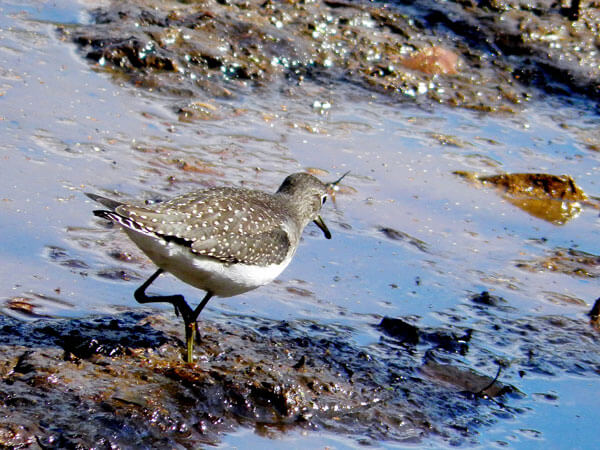By Michael Givant
On a fall-like Friday early in September, a cold front moved through the Jamaica Bay Wildlife Refuge, a stopover for migrating birds on their annual southward journey.
On the east side of the refuge at a blind overlooking Big John’s Pond, photographers are snapping pictures of small shorebirds feeding at low tide. Looking at tiny, feeding semipalmated sandpipers, spotted sandpipers and yellowlegs — all small shorebirds — I understand why Kevin Karlson, a shorebird expert who held a walk here two weeks prior, calls them “marsh mice.” That is just what they look like.
Nearby at a clearing in the huge East Pond, my eyes hardly believe what they are seeing. What looks like a million cormorants are moving their black necks and heads in different directions. They resemble dancing eels. The number is probably 400. They all take flight at my appearance.
Further down the shoreline are 14 great egrets and four snowy egrets all clustered up. An osprey flies over the pond looking for fish. It is a sign the water is shallow enough for them to hunt. At the pond’s south end, I see a solitary sandpiper, which does not remain for long. Taking off, the bird gives its characteristic high call.
At the East Pond all the cormorants and egrets are gone, possibly feeding elsewhere and fueling up for their long journeys to Florida, the Bahamas, Cuba and the Gulf Coast. There are at least a dozen mute swans all looking like headless white masses while their long, tube-like necks and heads are submerged.
A few momentarily raise their heads out of the water holding long strands of vegetation, upon which they feed. Sounds of unseen birds come from the dense vegetation and trees. Soon the sounds become higher and louder, as if they are a warning that a predator is in sight. I see a small bird in the air that does not appear to be a falcon.
The sounds stop. Why?
Back at the blind by Big John’s Pond, I watch several semipalmated sandpipers feeding in the mud. A photographer who has been there all day wonders how they can feed for so long. These 6.25-inch birds winter from South Carolina to Northern Brazil and need the energy provided by aquatic insects, bugs, crustaceans and worms.
Then I notice some tiny warblers to which the others have stopped paying attention. These tiny warblers are named redstarts and are black with orange streaks on their sides and tail.
The eye-catching birds have been here for hours and the photographers have become somewhat blasé about them. The redstarts are barely visible against dried leaves on mud and flit fast to a stick where they again do not rest for long.
What camouflage!


































